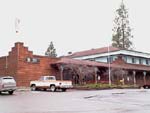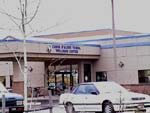 | | Benewah Medical Center. November 2002 |
The Benewah Medical and Wellness Center, located in Plummer near the Tribal Headquarters, provides state-of-the-art "primary, holistic, preventive, and wellness promotion to all members of the community as intended by the Creator" (from the mission statement). The area was once characterized by its poverty and lack of health care services. A third of the population was below 200% of the Federal poverty guidelines. Approximately 56% had no insurance coverage. Until recent years the unemployment rate was typically the highest in the state and double the national average. With only fragmentary care from the Indian Health Service and great distances to affordable health care for non-Indian residents, in 1987 the Coeur d’Alene Tribe initiated a plan to address this situation.
|
|
Listen as Norma Peone discusses what health care was like right before the opening of the Benewah Medical Center in 1990. In those days, the Indian Health Service provided a full-time nurse practitioner, a monthly visit by a physician and dental service every few months. (interviewed and edited by Rodney Frey, November 2002) |
The Coeur d’Alene Tribe made a tough decision to no longer rely upon the Indian Health Service for its medical services, but within the framework of self-governance, contract those services and provide health and wellness services themselves. Federal and state funding was secured through a number of grants and a unique partnership with the City of Plummer was forged (the first such joint venture in the United States between a Tribe and a city municipality). No Tribal gaming dollars were or have been used to finance the project.
|
|
Norma Peone considers the Tribe's decision to initiate their own health clinic, contracting it from the Indian Health Service, and some of the key individuals who assisted in the development of the health clinic, including Henry SiJohn, Margie Matheson Zarate and Gary Leva. When the doors opened in 1990, all in the community were welcomed and continue to be provided for, with 7-8,000 active patients being served today. (interviewed and edited by Rodney Frey, November 2002) |
As part of the first phase, in 1990 a 6,750 square foot building was opened with a staff of 14 and over 800 patients, establishing primary medical care for the community focusing on acute and chronic illness. Under a sliding fee scale, non-Indians were also welcomed. The service area included the Coeur d’Alene Reservation, as well as the surrounding counties of Idaho and extending into the state of Washington.
|
|
Listen as Norma Peone discusses some of services provided at the Benewah Medical Center, which include general practice and primary care, women’s issues, a pharmacy, dental and orthodontic services, baby wellness clinic, mental health and substance abuse, and diabetic care. (interviewed and edited by Rodney Frey, November 2002; additional video footage by Dan Kane, June 2001) |
Because of the strong demand for services, with close to 8,000 active patients today, and an annual budget in excess of 7 million dollars, phase two of the Tribe’s health care plan was implemented in 1994. The Medical Center was expanded to nearly 17,000 square feet, providing additional medical exam rooms, a five chair dental wing, increased space for pharmacy services, community health programs and conference rooms.
|
|
Norma Peone talks about some of the facilities and activities offered through the Coeur d'Alene Tribal Wellness Center. Like the Medical Center, the Wellness Center serves all in the community, focusing on comprehensive and integrated prevention and wellness services. (interviewed and edited by Rodney Frey, November 2002; additional video footage by Dan Kane, June 2001) |
 | | Wellness Center. November 2002 |
As prevention of illness and maintenance of wellness were also goals of the Tribe and City, phase three of the health care plan was implemented in 1998 when a 43,000 square foot, $5 million Wellness Center opened. Built debt-free from a number of Federal, State and private funding sources, the facility includes a 100,000 gallon lap pool, therapy pool, hot tub, kiddy pool, physical and cardiac therapy, full-sized basketball and racquetball courts, indoor walking track, aerobics and weight rooms, community health services, and conference rooms. A well-trained staff provides wellness information, complete fitness assessments and individualized exercise programs. The programs and facilities of the Wellness Center thus incorporate and continue many of the traditional health and exercise practices of the Schitsu'umsh, such as swimming, the use of the sauna, and competitive contact sports.
© Coeur d'Alene Tribe 2002
< previous |
next >
|



